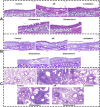Screening and identification of the H1R antagonists from natural products by BODIPY FL histamine recognition and DPHD-anchored bombardment coupled with target cell extraction
- PMID: 40520177
- PMCID: PMC12163627
- DOI: 10.3389/fphar.2025.1601384
Screening and identification of the H1R antagonists from natural products by BODIPY FL histamine recognition and DPHD-anchored bombardment coupled with target cell extraction
Abstract
Introduction: Histamine is an important mediator of allergy, and inhibiting its binding to H1 receptors (H1R) is a key method to alleviate allergic diseases. Natural products with anti-allergic properties are an important source of natural H1R antagonists.
Methods: In this study, a rapid method for identifying the H1R antagonists from natural products via the BODIPY FL histamine recognition and diphenhydramine (DPHD)-anchored bombardment coupled with target cell extraction was developed. In addition, the activity of the H1R antagonist was further validated both in vitro and in vivo through BODIPY FL histamine recognition, intracellular fluorescence calcium ion (Ca2+) kinetic recognition, molecular docking, and animal experiments.
Results: The binding of fluorescent histamine to H1R was notably inhibited by Ephedra sinica Stapf (ESS) and Dictamnus dasycarpus Turcz (DdT). Ephedrine and pseudoephedrine in ESS and dictamnine and limonin in DdT were screened as potential H1R antagonists using the target cell extraction of the DPHD-anchored bombardment. The BODIPY FL histamine recognition results revealed the significant blocking effects on H1R binding by pseudoephedrine (50 μM) and dictamnine (100 μM). Pseudoephedrine (200 μM) and dictamnine (100 μM) markedly decreased the histamine-induced increase in intracellular calcium ion (Ca2+) concentration. Docking results indicated strong binding affinity for both components to H1R, with dictamnine exhibiting a higher affinity than pseudoephedrine. Ultimately, the ameliorative effect of dictamnine on allergic rhinitis mice was confirmed through nasal symptom score, serum pharmacodynamic indices (immunoglobulin E (IgE), histamine, IL-2, IL-4, IL-6, and TNF-α), and histopathology.
Conclusion: This study showed that dictamnine (validated in vitro and in vivo) and pseudoephedrine (validated in vitro) may serve as potential H1R antagonists. This study offered valuable insights for future developments in antihistamines.
Keywords: BODIPY FL histamine; H1R antagonists; HPLC-Q-TOF-MS; dictamnine; natural products; pseudoephedrine; target cell extraction.
Copyright © 2025 Li, Hu, Chen, Di and Qi.
Conflict of interest statement
Author GH was employed by Jiangsu Kanion Pharmaceutical Co., Ltd. The remaining authors declare that the research was conducted in the absence of any commercial or financial relationships that could be construed as a potential conflict of interest.
Figures










References
LinkOut - more resources
Full Text Sources
Miscellaneous

